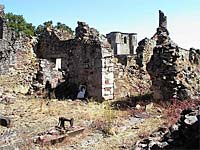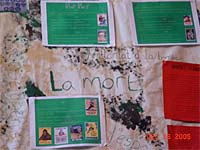
Home Page Project ListingsProject OverviewBackground / ContextLearning ResourcesUseful Links |
“Why We Shouldn't Forget “
SchoolWolgarston High School Specialist Technology College, Penkridge ContactJulia Richmond Aims/ObjectivesThe Project was designed and assembled by Leading Edge students. These students had taken their GCSE French exam a year early in 2005 and have gone on to work towards their Bronze Duke of Edinburgh’s Award. The Unity Project formed part of their 3-month minimum work towards the Skill Section of the Award. Material combined within the multi-media display comes from their own research from the Internet, books, videos and research undertaken by Year 9/10 students in History and students from this year’s Year 9 French. Sixth form students who undertook a work experience in France also contributed their thoughts on seeing the martyr village of Oradour-sur-Glâne near Limoges. The aim was to create a display that celebrated various technical skills as well as academic capability. Via research and gaining empathy with the experiences of those in WWII, students were asked to challenge themselves regarding their attitudes and values regarding many aspects linked to wars. Upon this reflection they were then asked to produce various pieces of work pertinent to themselves and their wishes and values. The initial stimuli ranged from historical, citizenship, linguistic and cultural. Students were encouraged to communicate and work together on tasks and the overall design and completion, and in trying to create a coherent result from the mass of information gathered students began to see beyond the sensationalism of war. ActivitiesHistory students were asked to research areas interesting to them and to produce an empathic presentation in whatever format they preferred. Internet and books were used to glean information. The French classes were given a range of projects, looking at key French towns, the differences in weaponry, the Resistance, researching words in French, Spanish and Italian linked with warfare- looking at the similarity between these words to English. They produced posters, power-point presentations, used key research skills, skimmed and scanned for information pertinent to their own chosen direction, wrote a reflective piece on why we shouldn’t forget and took part in group and one-to-one discussions of their work.
The Leading Edge groups managed these resources, in addition to their own, and created banners – looking at content, colours, textile techniques, painting styles, substances, and effect. Some students chose to design and make the Normandy beaches, a tank and an abstract falling aeroplane. The logistics of hanging this mural had to be dealt with by the students. Many skills were combined, language with art with history with citizenship with teamwork with individual work with working with peers and adults combined. The Sixth Form French Students undertook a work experience to Limoges in October 2005 and had the opportunity to visit Oradour-sur- Glâne, a martyr village massacred by the Germans and left as a standing memorial. The students saw the village deserted showing the aftermath of the destruction, the personal items and the stillness left exactly as the French people had found it after the tragedy. The historical accounts and video footage twinned with this experience was a moving one to all the 60 Staffordshire students involved. In addition to discussions and personal diary entries, some students produced dialogues based upon their empathic feelings derived from this stimulus. In working together, the students empathized in some way what can actually be achieved when various talents and commitment are combined in a useful and pro-active manner. In better understanding their history and by having the opportunity to produce something that was completely their own, students questioned their values and their twenty-first century view of their relationship with their country. OutcomesIn addition to the knowledge gained, the students involved have had an opportunity to create a lasting piece on artwork. Indeed, not all of the material was put on display and some, including the aeroplane is to be housed and shown in The Student and Family Services Centre. All community services will be able to see up close some of the research and the depth of interest studied by our students. Visitors, students and staff will have this opportunity alike. In pride of place in the School Hall the mural will be seen by many people and is a key talking point, even if not all of the information can be seen by all! The response has been positive and indeed it is the largest display in the school. By creating such a display, cross-curricular links have been melded, the fact that ‘real’ life can not be separated into subject and neatly defined areas has come to the fore and students are beginning to see that life experience and skills can also be transferable and flexible. In education skills and competences are often isolated per subject but this project has helped some students realize that actually the sum of your academic skills and your personal qualities is just as important in this life. And that is something that we should never forget, if we do not learn and evolve from our own and others’ experiences how do we move forward into a brighter life? |

